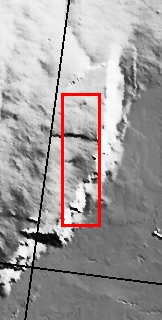
This nighttime IR image is of a portion of the flank of Olympus Mons. In last week's Arsia Mons flow images, it was easy to delineate lava flows. While this image is also of a region of extensive flows, it is nearly impossible to identify any flows. This illustrates one of the problems imaging high altitudes in nighttime IR, the surface is almost as cold as the atmosphere and is emitting very little signal back to the IR camera.
Image information: IR instrument. Latitude 16.4, Longitude 230.6 East (129.4 West). 100 meter/pixel resolution.
Note: this THEMIS visual image has not been radiometrically nor geometrically calibrated for this preliminary release. An empirical correction has been performed to remove instrumental effects. A linear shift has been applied in the cross-track and down-track direction to approximate spacecraft and planetary motion. Fully calibrated and geometrically projected images will be released through the Planetary Data System in accordance with Project policies at a later time.
NASA's Jet Propulsion Laboratory manages the 2001 Mars Odyssey mission for NASA's Office of Space Science, Washington, D.C. The Thermal Emission Imaging System (THEMIS) was developed by Arizona State University, Tempe, in collaboration with Raytheon Santa Barbara Remote Sensing. The THEMIS investigation is led by Dr. Philip Christensen at Arizona State University. Lockheed Martin Astronautics, Denver, is the prime contractor for the Odyssey project, and developed and built the orbiter. Mission operations are conducted jointly from Lockheed Martin and from JPL, a division of the California Institute of Technology in Pasadena.

